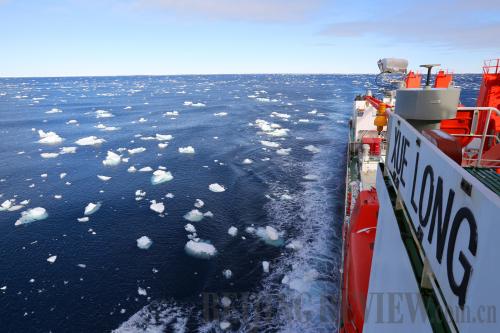|
 |
|
RETURN TRIP: Chinese icebreakerXuelong, which translates asSnow Dragon, sails through ice on its journey out of the Antarctic circle. Xuelong began its return journey on March 9 after an expedition lasting more than three months in Antarctic waters (BAI YANG) |
Garbage Treatment
More than 97 percent of China's urban household garbage was disposed of properly last year, according to a report released on March 6.
The 2014 report on the impact of solid waste on the environment in large and medium-sized Chinese cities was released by the Ministry of Environmental Protection.
The first-ever report said that China produced 161 million tons of household garbage and nearly 2.4 billion tons of industrial solid waste in major cities.
Shanghai produced more household garbage than any other city last year, according to the report.
Solid industrial waste was mainly produced in northern China, with Hebei and Shanxi provinces as well as Inner Mongolia Autonomous Region being the top three industrial waste producers, it said.
Cargo in Space
China will send a cargo vessel into space in 2016 to dock with a future space module scheduled to be launched earlier the same year, a leading space scientist revealed on March 6.
The Tianzhou-1, which literally means "heavenly vessel," will carry propellants, living necessities for astronauts, research facilities and repair equipment to China's second orbiting space lab Tiangong-2, said Zhou Jianping, chief engineer of China's manned space program.
Cargo transportation is a key technology China must master as well as making breakthroughs in building its own space station, said Zhou who is also a member of the National Committee of the Chinese People's Political Consultative Conference, the country's top political advisory body.
China's multi-billion-dollar space program, a source of surging national pride in the country, aims to put a permanent manned space station into service around 2022.
The country already launched its first space lab, Tiangong-1, in September 2011 and has conducted two dockings with the module in the following two years. In June 2013, three Chinese astronauts delivered a physics lesson onboard Tiangong-1.
S&T Investment
Chinese venture capital investors have invested more than 350 billion yuan ($56.8 billion) in science and technology companies, according to Wan Gang, Minister of Science and Technology.
More than 1,600 business incubators are providing services for science and technology companies, said Wan.
In 2014, total technology transaction volume reached 857.7 billion yuan ($138 billion), 15 percent higher than the previous year.
Wan commented that people could learn from original incubators, such as Garage Coffee in Beijing and Chaihuo Maker Space in south China's Shenzhen, to set up more platforms offering start-ups workplaces, networks, rooms for social and shared resources. | 